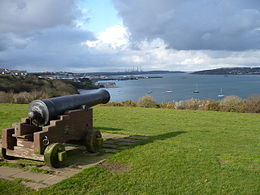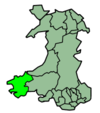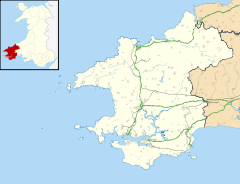- Pembroke Dock
-
Coordinates: 51°41′36″N 4°56′45″W / 51.69333°N 4.94584°W
Pembroke Dock Welsh: Doc Penfro 
 Pembroke Dock shown within Pembrokeshire
Pembroke Dock shown within PembrokeshirePopulation 8,678 OS grid reference SM965035 Principal area Pembrokeshire Ceremonial county Dyfed Country Wales Sovereign state United Kingdom Post town PEMBROKE DOCK Postcode district SA72 Dialling code 01646 Police Dyfed-Powys Fire Mid and West Wales Ambulance Welsh EU Parliament Wales UK Parliament Carmarthen West and South Pembrokeshire List of places: UK • Wales • Pembrokeshire Pembroke Dock (Welsh: Doc Penfro) is a town in Pembrokeshire, south-west Wales, lying north of Pembroke on the River Cleddau. Originally a small fishing village known as Paterchurch, the town was greatly expanded from 1814 onwards following the construction of a Royal Naval Dockyard. It is the third largest town in Pembrokeshire after Haverfordwest and Milford Haven.
Contents
History
Prior to 1814, the site of modern Pembroke Dock and its nearby settlements were mostly farmland and the area was referred to as Paterchurch. The first recorded mention of Paterchurch was in 1289. In the area a medieval tower was built and, like nearby 18th century and 19th century fortifications, it may have served as a lookout post. By the 17th century, additional domestic and farm buildings stood close to the tower and the isolated settlement had its own cemetery, whose last recorded burial is that of a Roger Adams, in 1731. The ruin of the tower now lies within the walls of the Dockyard.
Paterchurch Tower was the centre of an estate said to stretch from Pennar Point to Cosheston. This changed hands in 1422 when Ellen de Paterchurch married a John Adams. Prior to the building of the town and before the dockyard was thought of, various sales and exchanges took place between the principal local landowners - the Adams, Owen and Meyrick families. These exchanges left the Meyricks in control of most of the land on which the dockyard and new town were to develop. By 1802 the Paterchurch buildings were mostly ruins.
The Pater Tower should in all rights be open to the public but the County Council Refuse to open it up. Pembroke Dock is so Historical it needs to have it's history on display to the public.
The origins of naval shipbuilding on Milford Haven were in the private shipyard of Jacobs on the north side of the Haven at Milford. Following Jacobs's bankruptcy, the Admiralty took over his shipbuilding facility which became Milford Dockyard. With the end of the Napoleonic War, the Admiralty decided to relocate this facility to the village of Pater on the south side of the Haven. The town of Pembroke Dock was founded in 1814 when a Naval Dockyard was established, initially called Pater Dockyard. The Naval Dockyards Society published a historical review in 2004, and an online resource can be found at Pembroke Dock Community Web Project.
On 10 February 1816, the first two ships were launched from the dockyard – Post-ships, subsequently converted at Plymouth Dockyard into 26-gun ships. In the span of 112 years, five Royal Yachts were built, along with 263 other Royal Navy vessels. The last ship launched from the dockyard was the Royal Fleet Auxiliary tanker Oleander on 26 April 1922.
As the dockyard and its importance grew, the need to defend it was addressed and Pembroke Dock became a military town. Work began in 1844 to build defensible barracks. In 1845 the first occupiers were the Royal Marines of the Portsmouth Division followed though the years by many famous regiments. Between 1849 and 1857, two Martello towers of dressed Portland stone were constructed at the south-western and north-western corner of the Dockyard. Both were garrisoned by Sergeants of Artillery and their families.
In 1925, it was announced that the Royal Dockyards at Pembroke Dock and Rosyth were to close. A petition to Prime minister Stanley Baldwin stressed the lack of alternative employment and the economic consequences, but the decision, however, was irreversible. The Navy simply had too many dockyards and the Admiralty had to keep a fleet together with much-reduced funds. The choice was laid out starkly by the First Sea Lord, Admiral of the Fleet Earl Beatty, in his speech at The Lord Mayor’s Banquet on 9 November 1925: ‘Whether these Yards are necessary for naval purposes, the Admiralty is the only competent judge. As to whether they are necessary for political or social reasons is for the Government to decide. The fact is, that so far as the upkeep of the Fleet is concerned, they are entirely redundant.’[1]
On 4 April 1956 the hulk of the old iron screw frigate, HMS Inconstant, which Lady Muriel Campbell had ‘gracefully and dexterously [sic]’ launched at Pembroke Dockyard on a Thursday afternoon in 1868, arrived at a Belgian port for breaking-up. She was the last Pembroke-built ship afloat. On 29 June that year, Admiral Leonard Andrew Boyd Donaldson, the last Captain-Superintendent of Pembroke Dockyard, died aged eighty-one in a Portsmouth hospital. The last ship and the last sailor had gone to their haven under the hill just thirty years after the closure of His Majesty’s Royal Yard at Pembroke Dock.[2]
Although active warships were not based in Pembroke Dock after the 1940s, and formal dockyard work ceased in 1926, the base remained an official Naval Dockyard, and retained a Queen's Harbour Master, until 2008 (one of the last 5 QHMs in the UK, together with those at the currently (2010) extant bases at Devonport, Portsmouth, Rosyth and Clyde). The Royal Maritime Auxiliary Service (RMAS) was based in Pembroke Dock until disestablishment in 2008,[3] and the Ministry of Defence sold the freehold of the site to the Milford Haven Port Authority (MHPA)[4] in 2007. For most of the last 20 years of MOD usage, the principal RMAS assets seen in the base were the MOD Salvage & Mooring Team (formerly CSALMO) vessels located there, the majority of which were relocated to the Serco base in Burntisland on the River Forth upon the activation of the £1bn Future Provision of Marine Services (FPMS) contract in May 2008.[5]
RAF Base
With the closure of the dockyard in 1926, also the year of the 1926 United Kingdom general strike, unemployment was high through the Great Depression until 1931 when No. 210 Squadron RAF arrived equipped with Southampton II flying boats. For almost 30 years the Royal Air Force were based at Pembroke Dock. During 1943, when home to the Sunderland flying boats, it was the largest operational base for flying boats in the world.
Given its importance as an RAF base, it was no surprise that during World War II Pembroke Dock was targeted by the Luftwaffe. On Monday 19 August 1940 a Luftwaffe Junkers Ju 88 bomber flew up the Haven waterway and bombed a series of oil tanks sited at Pennar. The oil fuelled fire that followed raged for 18 days and was recorded as the largest UK conflagration since the Great Fire of London.
Following the war the town enjoyed a degree of prosperity; this, however, changed in 1957 when it was announced that the RAF would be drastically reducing its presence. A few years later the final British Army regiment also left the town.
The town's prosperity did increase again with the opening of the oil refineries on the Milford waterway and the construction of an oil fired power station, but never to the high levels experienced when the dockyard was fully operational.
Pembroke Dock also has a link to Hollywood - the full-scale Millennium Falcon built for The Empire Strikes Back was created in one of Pembroke Dock's hangars by Marcon Fabrications in 1979.[6]
Today
Today, much of Pembroke Dock's maritime industry has gone. The town continues to cope with high unemployment, limited public and private investment, and decaying buildings. The town briefly had a resurgence in the late 1990s and early 2000s with the arrival of large superstores such as Tesco and Asda the development of the Cleddau Business Park, and also the local Peacocks. Like many high streets in provincial towns Pembroke Dock has struggled especially with the closure of Woolworths at the end of 2008. At present the main retail street (Dimond Street) has several large retail units closed down.
The town was badly affected by the collapse of ITV Digital in 2002, from which their main customer call centre was based. Much of the green field land set aside for development of the Cleddau Business Park remains unsold and undeveloped. The Pembrokeshire Technium[7] was built and opened in 2006. Although the initial interest was slow the first major uptake on this facility began in 2009 when Infinergy built a wind farm[8] in the local area and based its local office in the centre. There has been approval given by Pembrokeshire County Council for a new yacht marina to be built alongside Front Street but work has yet to begin.
The two Martello Towers remain: one is now a local museum, while the other is in private hands and has been converted for residential use and is largely intact. The dockyard wall is substantially complete and has been recently repaired by experts with dressed stone and lime mortar. The two listed hangars built to house the Sunderland flying boats used to guard the Western Approaches, have been rebuilt and now used for other uses. The Dockyard church has been rebuilt using Objective One funding from the European Union and has yet to find a new use.
A few buildings on the site of the old Llanion Barracks still stand. The Officers' and Sergeants' Mess once used as council offices is now occupied by Pembrokeshire Coast National Park. The Original Guardroom remains and is now residential accommodation and a listed Victoria Powder Magazine[9] remains set in to the coastal slope which is accessible from Connacht Way. The old parade square has recently been converted for housing.
Pembroke Dock is well-served by the A477 trunk road which runs from St. Clears through Pembroke Dock and over the Daugleddau estuary via the Cleddau Bridge to Haverfordwest. It also has a ferry terminal from which ferries sail twice-daily to Rosslare in Ireland. The service is operated by Irish Ferries.
The town is served by Pembroke Dock railway station.
Proposals to re-name the town
There have been a number of occasions over the years (most recently in 2003)[10] when it has been suggested that Pembroke Dock should undergo a change in name in order to improve the town's image in respect of it reputation for high unemployment and industrial decline. Suggestions for a new name have included Pembroke Haven, Pembroke Harbour and a reversion to the original pre-1814 name of Paterchurch. To date none of these proposals have come to fruition.
See also
References
- ^ From W.S. Chalmers, The Life and Letters of David, Earl Beatty (1951), p.469 (courtesy of http://www.pembrokedock.org/h_dockyard_2.htm)
- ^ From "History of Pembroke Dock" at http://www.pembrokedock.org/h_dockyard_2.htm
- ^ http://www.mod.uk/NR/rdonlyres/8F4E1958-BAB2-4E59-BB71-76D61C28BD1D/0/desider_01_may2008.pdf Page 26
- ^ http://www.mhpa.co.uk/uploaded/docs/mhpa%20annual%20report%202006.pdf Page 9
- ^ http://www.serco.com/media/pressreleases/2006/marineservices.asp
- ^ Parry, Nick (2005-05-18). "Town's secret Star Wars history". BBC News. http://news.bbc.co.uk/2/hi/uk_news/wales/south_west/4555455.stm. Retrieved 2010-04-14.
- ^ "Technium Project". Pembroke Dock Community Web Project. http://www.pembroke-dock.co.uk/technium_project.htm. Retrieved 2010-04-14.
- ^ "Castle Pill Farm windfarm, United Kingdom". http://www.thewindpower.net/wind-farm-1413-castle-pill-farm-nordtank-ntk500-37.php. Retrieved 2010-04-14.
- ^ "Pembroke Dock - Llanion Barracks - 4 Group AAOR for the Milford Haven GDA". Subterranea Britannica. 2002-11-12. http://www.subbrit.org.uk/rsg/sites/l/llanion_barracks/index.html. Retrieved 2010-04-14.
- ^ "'Ditch Dock' town is urged". BBC News. 16 May 2003. http://news.bbc.co.uk/1/hi/wales/south_west/3034617.stm.
External links
- Pembroke Dock Community Web site
- Pembroke & Pembroke Dock Web site
- LLanion Communities First Website
- Pembroke Dock Sunderland Flying Boat on TV documentary Wreck Detectives
- Pembroke Dock Garrison Regiments
- Pembroke Dock Sunderland Trust
- The Wartime Memories Project - RAF Pembroke Dock
- www.geograph.co.uk : photos of Pembroke Dock and surrounding area
Communities of Pembrokeshire 
Ambleston · Amroth · Angle · Boncath · Brawdy · Burton · Camrose · Carew · Castlemartin · Cilgerran · Clydau · Clynderwen · Cosheston · Crymych · Cwm Gwaun · Dale · Dinas Cross · East Williamston · Eglwyswrw · Fishguard & Goodwick · Freystrop · Haverfordwest · Hayscastle · Herbrandston · Hook · Hubberston Hundleton · Jeffreyston · Johnston · Kilgetty/Begelly · Lampeter Velfrey · Lamphey · Letterston · Llanddewi Velfrey · Llandissilio West · Llangwm · Llanrhian · Llanstadwell · Llawhaden · Maenclochog · Manorbier · Manordeifi · Marloes and St Brides · Martletwy · Mathry · Merlin's Bridge · Milford Haven · Mynachlog-ddu · Narberth · Nevern · New Moat · Newport/Trefdraeth · Neyland · Nolton and Roch · Pembroke · Pembroke Dock · Penally · Pencaer · Puncheston · Rosemarket · Rudbaxton · Saundersfoot · Scleddau · Slebech · Solva · Spittal · St Davids · St Dogmaels · St Florence · St. Ishmael's · St Mary Out Liberty · Stackpole · Templeton · Tenby · The Havens · Tiers Cross · Trecwn · Uzmaston and Boulston · Walwyn's Castle · Wiston · Wolfscastle
Transport in Pembrokeshire Road 
National Cycle Network Railway lines Railway stations Clarbeston Road · Clunderwen · Fishguard Harbour · Haverfordwest · Johnston · Kilgetty · Lamphey · Manorbier · Milford Haven · Narberth · Pembroke Dock · Pembroke · Penally · Saundersfoot · Tenby
Air Sea Fishguard Harbour · Pembroke Dock · Milford Haven Harbours of the UK
Harbours of the UKEngland Wales Barry Docks · Cardiff Docks · Fishguard Harbour · Milford Haven · Newport Docks · Pembroke Dock · Port of Port Talbot · Swansea DocksScotland Northern Irelend Categories:- Towns in Pembrokeshire
- Ports and harbours of Wales
- Transport in Pembrokeshire
Wikimedia Foundation. 2010.



